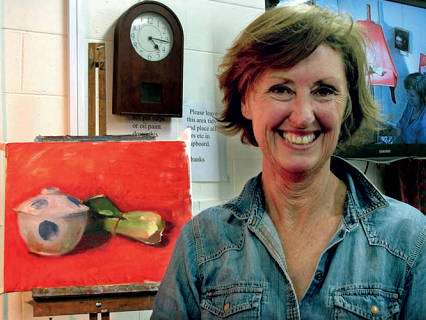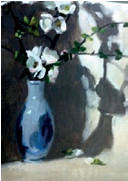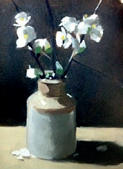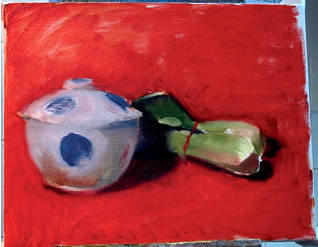Vikki McInnes Demonstration 20th September 2014
Still Life in Oils
 Tonalism
in two hours! A big ask! However, Vicki who has mastered this technique
managed to take us through all the basics of Tonalism in just over two
hours. Her award winning paintings are testament to how effective this
approach can be.
Tonalism
in two hours! A big ask! However, Vicki who has mastered this technique
managed to take us through all the basics of Tonalism in just over two
hours. Her award winning paintings are testament to how effective this
approach can be.
Vicki inherited her artistic ability and love of art from her grandparents, both artists. Her grandfather, W B McInnes, won the Archibald Prize seven times, so Vicki grew up surrounded by lovely paintings and involved in discussions of art. Advised to “get a real job” she persevered with that for a short while before taking lessons under Don James at Montsalvat. Don was trained by Max Meldrum who developed Tonalism in Australia.


Vicki still attends classes at Montsalvat from time to time and keeps all the class exercises as a “notebook” that she can refer back to and possibly use for a future painting. She passed some examples around.
A couple of the exercises
Vicki passed around -
the one at far right uses the shadow
to balance the composition.
Tonalism relies on painting rather than drawing. Tone versus shapes with minimal detail – light and dark are important. At the start there are no edges, they come in last. Start with the eyes half closed. In a tonal still life the approach is to set up the still life and then look at it from different angles and levels. Sometimes the composition might use shadows to balance the picture. They also look for reflections and the interaction of shadows and lighting.
Tonalism is a set of rules to follow – a formula for approaching painting and working one's way through it. It aims to make things simple and easy to follow. When asked to comment on Walter Magilton's approach of putting things where he wants them in the painting, e.g. moving the gum tree or putting one in that isn't there, she said that Tonalism does not allow that. If it is there, you paint it there. If you don't want it in the picture, move somewhere else! For Vicki it is important to have a subject that appeals to her, but to work with it so that it makes a good picture. 2 hours setting up is 2 hours well spent. She evaluates it according to colour, light and shade, using a viewer which allows her to see it as it will be and enables her to crop the image. When using a viewer, where she is standing becomes the viewing position. When she needs to check something, she must go back to this viewing position, not just look from the easel which is a different perspective.
Vicki set her palette up with colours ranging from black, through blues, reds, yellows to white – a fairly standard tonalist palette. Next she mixed colours for each tone in the subject, starting with the darkest and moving to the lightest, with a separate brush for each – about a dozen.
Don James apparently once did a painting that took 29 brushes. Mixing the colours at this stage can sometimes take up the full 2 hour session after which according to Vicki one needs to have a lie down!
Vicki uses good quality oil paints and linseed oil as her medium. She says if you are starting out and only have cheap paints it is better to have a go rather than not paint at all. She prefers brushes with a point. She feels that square brushes do not enable you to paint curves easily.
“Where do I start?” She doesn't draw an outline of the objects, just a couple of marks to define the top, bottom, left and right extremities of the objects, blocks in some background colour, then starts with what is going to make the biggest difference in getting the canvas like the subject. She started with the dark on the bok choy and the shadows. If you put the colour in the wrong place, just lift off with a rag. In this method, you are painting patches of light and dark, not edges. The objects will look after themselves. As humans we look for edges, but as artists it is the tones and colours that are the priority.
At the point where you need to be accurate about where things are, you need to use direct measurement to check the proportions and angles. She used a pencil to check the length of the bok choy and the width and height of the bowl. Then with a straight arm, she used the pencil to check the angles of the bowl.
While painting, Vicki chatted and shared her views. Regarding the use of photos: a photo is a single moment; whereas when painting directly from the subject you are painting through time and there will be slight variations. The camera and printers are filters which give variations in colour. When you take a photo to paint from, try to do a sketch and familiarise yourself with the tones and colours that are there. Print 3 or 4 copies of the photo with variations – lighter/darker; warmer/cooler.
She is always looking at the biggest difference in determining the next
step. She uses her finger to move colour and set up a smoother surface.
Edges should be as you see them. If crisp, then that is what
 you
paint. Jump from light to dark. Where it is hard to see the edge e.g. warm
dark against cool dark in the shadows of the bowl and bok choy, it should
be hard to see them in the painting. She comes back to smudge some of the
edges to take off the ridges of paint, but don't smudge them all. If you
have to stop part way through your still life, put your fruit and
vegetables in the fridge in plastic and mark the placement on the cloth.
you
paint. Jump from light to dark. Where it is hard to see the edge e.g. warm
dark against cool dark in the shadows of the bowl and bok choy, it should
be hard to see them in the painting. She comes back to smudge some of the
edges to take off the ridges of paint, but don't smudge them all. If you
have to stop part way through your still life, put your fruit and
vegetables in the fridge in plastic and mark the placement on the cloth.
The progress by the end of the demo
Helen Halliday, WAA Newsletter Editor